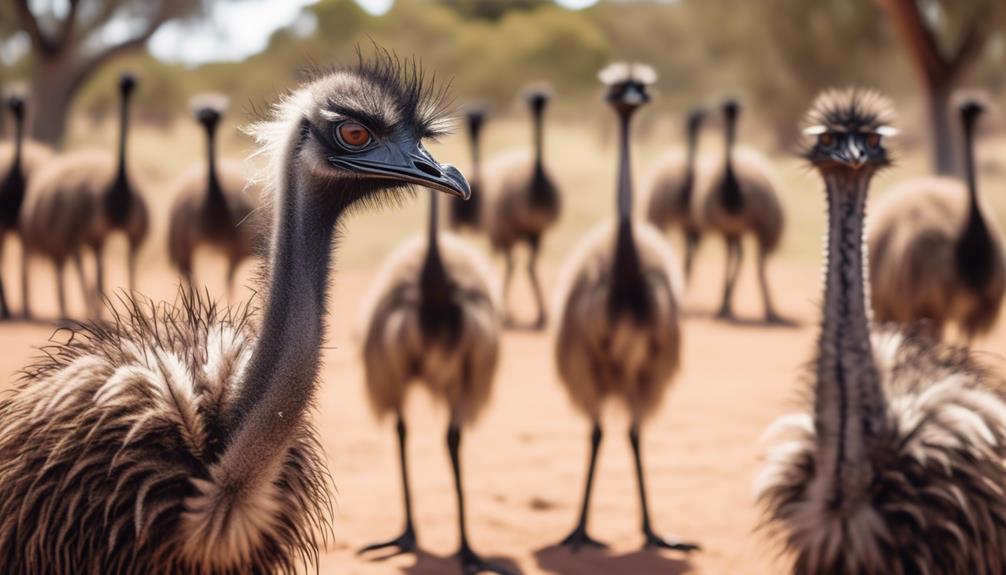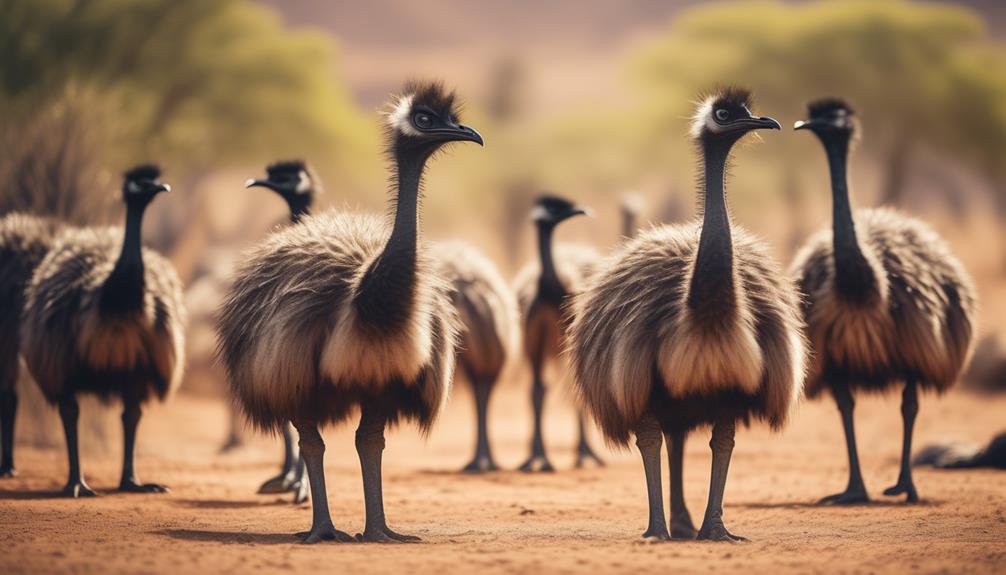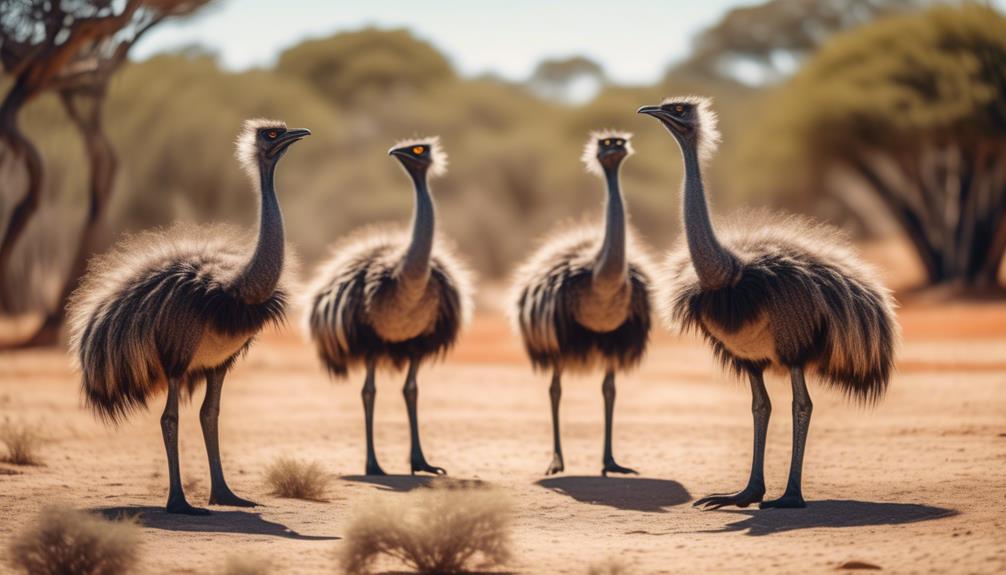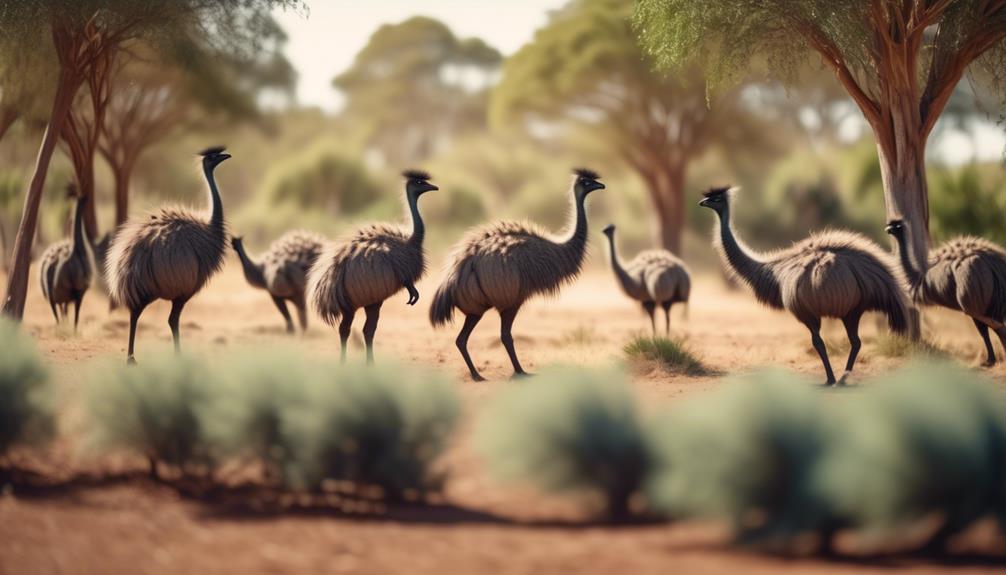
Emu groups, fascinating and intricate, are a subject worth exploring. Within these wild avian communities, social structure plays a vital role in their survival and success. How do these majestic birds establish their hierarchies? What roles and responsibilities do they assign to each member? And, perhaps most intriguingly, what are their communication patterns like?
As you delve into the social dynamics of wild emu groups, you will uncover a world filled with intricate relationships and captivating behaviors that shape their existence. So, let's embark on this journey, where the mysteries of the emu's social structure await.
Key Takeaways
- Emu groups, known as mobs, are highly social and consist of several individuals.
- Dominant emus display aggressive behaviors and assert their authority within the group.
- Subordinate emus occupy lower positions and assist in group protection, nest-building, and incubating eggs.
- Emus communicate through duetting, alarm calls, and parent-offspring communication, which help maintain order and ensure group safety.
Emu Group Dynamics
How do wild emu groups interact and function in their social dynamics? Let's delve into the fascinating world of emu group dynamics.
Emus are highly social birds, and their interactions within a group are crucial for survival. Group cohesion plays a vital role in their social dynamics, ensuring the overall well-being and protection of the members.
Emu groups, known as mobs, consist of several individuals, usually ranging from 5 to 30 birds. These mobs establish and defend territories, exhibiting territorial behavior that helps maintain order and resource availability. The size of the territory depends on factors such as food availability and habitat suitability.
Within the group, there's a hierarchical structure, with dominant males and females exerting influence over subordinate members. Dominant birds display aggressive behaviors, such as charging, wing flapping, and vocalizations, to establish and maintain their status.
Communication is vital for group cohesion, and emus employ a range of vocalizations to convey messages. These vocalizations vary in pitch, duration, and intensity, conveying different meanings such as alarm calls, courtship calls, and contact calls.
Understanding the intricacies of emu group dynamics provides insights into their social structure and behavior. It highlights the importance of group cohesion and territorial behavior in their everyday lives, ultimately contributing to their survival in the wild.
Social Hierarchy in Emu Communities
In emu communities, a clear social hierarchy is established through dominant individuals exerting influence over subordinate members. This dominance hierarchy plays a crucial role in shaping the social interactions within the community.
Here are three key observations about the social hierarchy in emu communities:
- Dominant individuals: Within the emu community, there are individuals who exhibit dominance over others. These dominant emus assert their authority through displays of aggression, such as pecking or chasing subordinate members. They often have access to better resources and receive preferential treatment from other emus.
- Subordinate individuals: Subordinate emus, on the other hand, occupy lower positions in the social hierarchy. They're often on the receiving end of aggression from dominant individuals and are expected to submit to their authority. Subordinates may be excluded from certain resources or face limited access to mates.
- Maintaining order: The dominance hierarchy helps maintain order within the emu community. By establishing clear social ranks, conflicts and competition for resources are minimized. This hierarchical structure provides stability and allows emus to allocate resources efficiently.
Understanding the dominance hierarchy and its impact on social interactions is crucial for comprehending the dynamics of emu communities. By studying these interactions, researchers can gain insights into the social relationships and behaviors of these fascinating birds.
Roles and Responsibilities Within Emu Groups

Having established the importance of the dominance hierarchy in emu communities, let's now explore the various roles and responsibilities that exist within these groups. Emu groups exhibit a strong sense of group cohesion, relying on social interactions to maintain order and function effectively.
Within the emu community, there are several distinct roles and responsibilities that contribute to the overall well-being of the group. The dominant male, or alpha male, takes on the primary role of protecting the group from potential threats. He's responsible for leading the group during foraging and ensuring their safety.
The dominant female, on the other hand, plays a crucial role in reproduction and raising the young. She chooses a mate based on his dominance and displays of strength, ensuring the survival of the offspring. The dominant female also leads the group during migration, guiding them to new feeding grounds.
Other members of the emu group, such as the subordinates, have their own responsibilities as well. They assist in the protection of the group by actively scanning the surroundings for potential dangers. They also participate in communal nest-building and the incubation of eggs.
Communication and Vocalization Patterns
Communication and vocalization patterns play a crucial role in the social dynamics and coordination of wild emu groups. These patterns are essential for maintaining group cohesion and facilitating various activities. Here are three fascinating aspects of vocalization patterns and communication dynamics observed in wild emu groups:
- Duetting: Emus engage in duetting, a unique vocal behavior where male and female emus take turns producing low-frequency drumming sounds. This synchronized vocalization serves as an essential means of communication between mated pairs and helps establish territorial boundaries.
- Alarm Calls: Emus emit distinct warning calls when they perceive potential threats or predators nearby. These alarm calls vary depending on the type of danger encountered, with different vocalizations for aerial predators, terrestrial threats, or unfamiliar sounds. This communication enables rapid coordination within the group, ensuring the safety of all members.
- Parent-Offspring Communication: Emu parents and their chicks maintain constant vocal contact for effective communication. Chicks emit soft chirping sounds to maintain proximity with their parents, while adults respond with low-frequency booming calls to provide reassurance and guidance. This communication dynamic helps keep the vulnerable chicks protected and allows the parents to monitor their whereabouts.
Understanding these vocalization patterns and communication dynamics provides valuable insights into the social structure and coordination within wild emu groups. By unraveling the complexities of emu communication, we gain a deeper appreciation for the intricate dynamics that contribute to their survival and success in the wild.
Reproduction and Breeding Strategies

Emu breeding and reproductive strategies involve a complex interplay of behaviors and adaptations that contribute to their successful reproduction in the wild. Emus exhibit interesting mate choice patterns and territoriality, which are essential for their reproductive success.
Mate choice in emus is influenced by various factors, including physical characteristics and displays. Male emus are known for their elaborate courtship displays, which involve puffing up their chests, shaking their feathers, and emitting low-frequency booming sounds. These displays serve as signals of their fitness and attractiveness to females. Females, on the other hand, select mates based on these displays and the overall health of the males.
Territoriality is another important aspect of emu breeding strategies. During the breeding season, males establish territories and defend them vigorously against other males. These territories provide resources such as food, water, and nesting sites, which are crucial for successful reproduction. Males use their booming calls and aggressive behaviors to deter intruders and attract females to their territories.
To provide a clear overview of emu breeding and reproductive strategies, the following table summarizes the key behaviors and adaptations involved:
| Aspect | Description |
|---|---|
| Mate choice | Male emus perform elaborate courtship displays to attract females. Females select mates based on displays and overall male health. |
| Territoriality | Males establish territories and defend them against intruders. Territories provide resources necessary for successful reproduction. |
Cooperative Parenting in Emu Groups
Cooperative parenting is an essential aspect of emu group dynamics, contributing to the successful rearing of offspring in the wild. Emus exhibit remarkable parental care behaviors that involve both males and females. Here are three fascinating observations about cooperative parenting in emu groups:
- Shared Incubation: Emus engage in shared incubation, where the male and female take turns incubating the eggs. The male initially constructs a nest and attracts a female to lay her eggs. Once the female lays her eggs, she leaves the male to incubate them while she moves on to find another mate. The male takes sole responsibility for incubation, tending to the eggs meticulously until they hatch, which usually takes about 50 days. This shared incubation strategy allows both parents to contribute to the survival of their offspring.
- Nest Defense: Emu parents diligently protect their nests from predators. They take turns guarding the nest, with one parent keeping watch while the other feeds or rests nearby. The vigilant parent stands tall, observing its surroundings, ready to warn others of approaching danger. This cooperative nest defense ensures the safety of the eggs and increases the chances of successful hatching.
- Chick Rearing: Once the eggs hatch, both parents actively participate in chick rearing. The chicks stay close to their parents, who provide them with protection, guidance, and food. Emu parents teach their chicks essential survival skills, such as foraging for food and avoiding predators. This cooperative effort between the parents ensures the survival and development of the young emus.
Foraging and Feeding Behavior

Emus in the wild exhibit distinct foraging and feeding behavior patterns that contribute to their survival and overall ecological impact. These behaviors are shaped by the competition for resources and the need to efficiently obtain food.
Emus are herbivores, primarily feeding on grasses, seeds, fruits, and insects. They have a unique group foraging strategy where they form small groups of up to 10 individuals to search for food. This strategy allows them to cover larger areas and increases their chances of finding food. Within these groups, emus take turns foraging and keeping watch for potential predators. This cooperative behavior not only maximizes their foraging efficiency but also enhances their overall safety.
Emus are known for their ability to consume a wide variety of plant species, making them adaptable to different ecological conditions. They have a specialized digestive system that allows them to extract nutrients from tough and fibrous vegetation. By consuming a diverse range of plants, emus play a crucial role in seed dispersal, contributing to the regeneration of plant populations and the maintenance of biodiversity in their habitats.
Observations have shown that emus also engage in opportunistic feeding, taking advantage of seasonal abundance and different food sources. During times of scarcity, they may resort to digging up tubers and roots to supplement their diet. This flexible feeding behavior enables emus to survive in unpredictable environments where food availability fluctuates.
Emu Mating Systems and Pair Bonding
The foraging and feeding behavior of wild emus sets the stage for an exploration of their mating systems and pair bonding dynamics. Emus have intricate mate selection processes that involve both male and female individuals. Here are some key observations regarding their mating systems:
- Monogamous Behavior: Emus are known for their monogamous behavior, where a male and female form long-term pair bonds during the breeding season. Once a pair bond is established, the male and female emus remain faithful to each other, sharing parental responsibilities and defending their territory together.
- Courtship Rituals: Emu courtship rituals are fascinating to observe. Males engage in elaborate displays, such as puffing up their feathers, drumming their wings, and emitting low-frequency booming vocalizations. These displays help attract a female mate and establish dominance over other males in the area.
- Selective Mating: Emus exhibit selectivity in their choice of mates. Females are known to evaluate males based on their physical condition, including their size, strength, and overall health. Males with desirable traits are more likely to be chosen as mates, ensuring the survival of their genetic lineage.
Understanding the mating systems and pair bonding dynamics of wild emus provides valuable insights into their social structure and reproductive strategies. These observations shed light on the intimate connections that exist within emu communities, highlighting the importance of mate selection and monogamous behavior in their breeding ecology.
Dispersal and Formation of New Emu Groups

Dispersing from their established pairs, wild emus embark on a quest to form new social groups. This dispersal is essential for the emu population growth and the maintenance of genetic diversity within the species. As emus disperse, they encounter various individuals and evaluate potential mates and rivals. This process is crucial for the formation of new emu groups.
Emus disperse in search of suitable habitats and resources, such as food and water, which are essential for their survival. During this dispersal, they may encounter other emus and establish new social groups. These groups consist of individuals that share common resources and form cohesive units.
The formation of new emu groups plays a significant role in maintaining genetic diversity within the species. When emus disperse and form new groups, they bring together individuals with different genetic backgrounds. This genetic diversity is important for the long-term survival of the species, as it increases their ability to adapt to changing environments and resist diseases.
Interactions With Other Species
During their dispersal process, wild emus engage in various interactions with other species, which can have significant impacts on their survival and ecological dynamics. These interactions shape the social structure of emu groups and influence their behavior and distribution. Here are some observations on the interactions with predators and other bird species:
- Interactions with predators: Emus, being large flightless birds, face predation risks from predators such as dingoes and foxes. They employ various strategies to avoid or defend against these predators. Emus often form loose groups that provide safety in numbers, and their large size acts as a deterrent against potential predators. Additionally, emus are known to respond to the alarm calls of other bird species, which can alert them to the presence of predators and enable them to react accordingly.
- Interactions with other bird species: Emus coexist with a diverse range of bird species in their environment. They often interact with smaller birds such as magpies and crows, which can act as both competitors and potential sources of information. Emus may engage in territorial disputes with these birds, especially during the breeding season when resources become limited. They also exhibit opportunistic behavior by following other bird species, taking advantage of their foraging activities to find food.
These interactions with predators and other bird species highlight the complex dynamics within the wild emu ecosystem. By understanding these interactions, we gain insights into the survival strategies and social behavior of emus in their natural habitat.
Factors Influencing Emu Group Dynamics

Emu group dynamics are influenced by a variety of factors, including their interactions with predators and other bird species in their environment. One key factor that affects the dynamics of emu groups is predator avoidance. Emus are known for their ability to detect and respond to potential threats, such as dingoes or foxes. When a predator is present, emus tend to gather in larger groups, as the collective vigilance of a larger group enhances their chances of detecting and evading predators. This is especially important during the breeding season when emus are more vulnerable to predation.
Another factor that influences emu group dynamics is group size. Emu groups typically consist of a dominant male and several females, along with their offspring. The size of the group can vary depending on factors such as resource availability and social relationships within the group. Larger groups provide more protection against predators, but they also require more resources, such as food and water.
Smaller groups may be more efficient at foraging, but they're also more vulnerable to predation. Therefore, emus must strike a balance between group size and predator avoidance to ensure the survival and reproductive success of the group.
Frequently Asked Questions
How Do Emus Establish Their Social Hierarchy Within a Group?
Emus establish their social hierarchy through a complex process of dominance. They assert their rank through displays of aggression and submission, creating a bond that reinforces group cohesion and ensures the survival of the fittest.
What Are the Different Roles and Responsibilities Within Emu Groups?
In an emu group, different roles and responsibilities emerge to maintain order and cooperation. The dynamics of an emu group's social structure are shaped by factors such as age, size, and dominance.
How Do Emus Communicate With Each Other and What Vocalization Patterns Do They Use?
Emus use a variety of vocalizations and nonverbal communication to interact with each other. They make deep booming sounds during courtship and territorial disputes, and use soft grunts to communicate with their chicks.
What Are the Reproductive and Breeding Strategies of Emus?
Emus have fascinating reproductive and breeding strategies. Their reproductive success is influenced by mate selection. By observing wild emu groups, we can gain insights into how these strategies contribute to their survival and species continuity.
How Do Emus Interact With Other Species in Their Environment?
Emus interact with other species in their environment through a variety of behaviors. They have complex interactions with predators, such as defensive postures and vocalizations, while their interactions with prey involve foraging and consuming plant matter.
Conclusion
In conclusion, the social structure of wild emu groups is a complex and fascinating phenomenon. Through observing their group dynamics, it becomes evident that social hierarchy plays a crucial role in their communities.
Each member has distinct roles and responsibilities, communicated through unique vocalization patterns. Emu groups also exhibit strategic breeding and mating systems, which contribute to their reproductive success.
Interactions with other species and various environmental factors further influence their group dynamics. Understanding these intricate dynamics provides valuable insights into the behavior of these remarkable birds.




